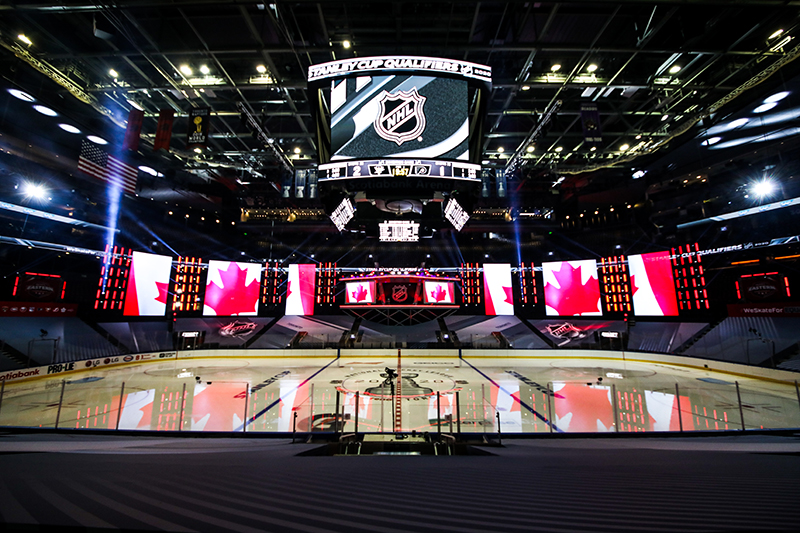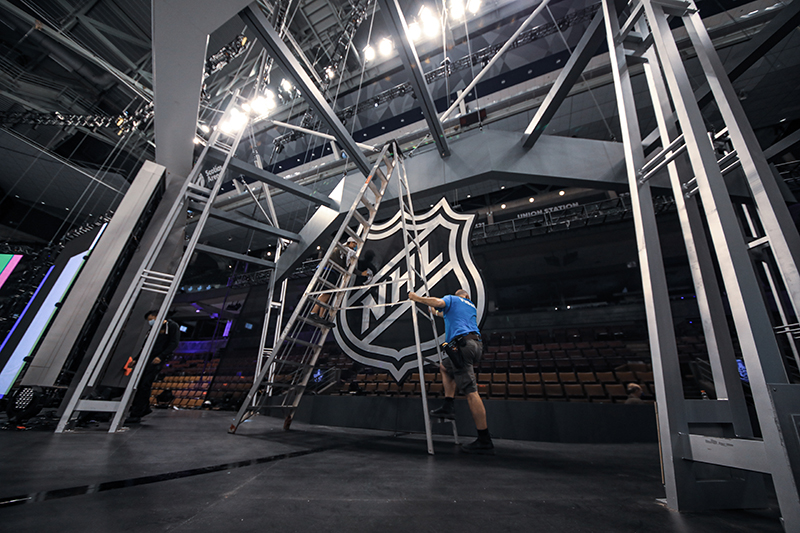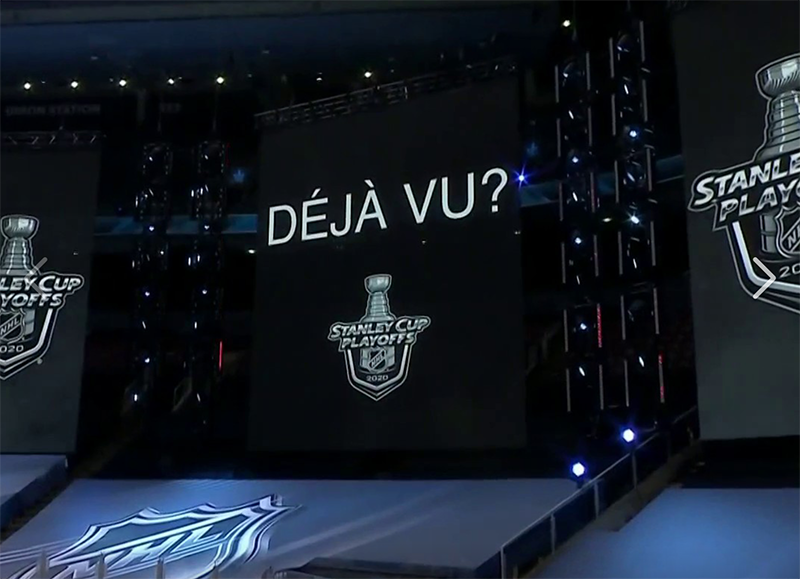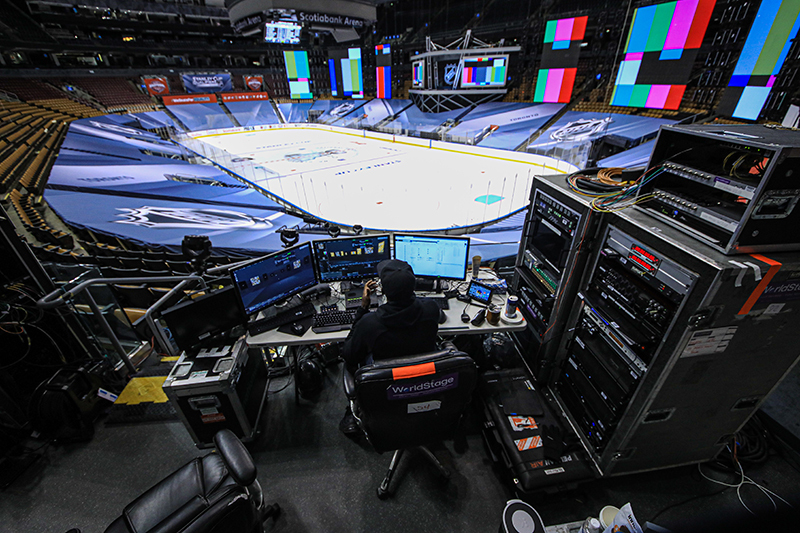
Two Months, Two Cities and Two Quarantined Crews Keep Vendors Paid and TV Audiences Engaged
Hockey fans have a reason to cheer – and they’re doing it safely at home. Because while the rest of the entertainment world is “on ice” – frozen in time since March – the National Hockey League (NHL) has returned to the rink after a 142-day pause in the 2019-20 season to play without live audiences.
For the 2020 Stanley Cup Playoffs, production teams are joining players, coaches, team and League personnel in two secure zones – known as “bubbles” – for two months in Canada. The Eastern Conference teams are competing at Scotiabank Arena in Toronto and the Western teams at Rogers Place in Edmonton, Alberta. The goal is to crown a Stanley Cup champion by early October.
Another reason to cheer is this: people are working. Production crews, equipment vendors, stadium workers, hotel staffers, catering company trucks, security guards, sanitation staff and many more are hired to support the effort in isolation. And so far, the resumption of play has been a success.

‘Let’s Make an Empty Arena Look Awesome’
The project started with relationships. NHL Chief Content Officer Steve Mayer called on his “two entertainment friends” Gary Wichansky and Tom Kenny. Wichansky is CEO and Head of Creative at Seattle-based production design firm Hotopp. Kenny is the longtime lighting designer for The Who, who calls Mayer “a game changer in events and the sporting world.” Both have worked with Mayer on other NHL gigs.
It was May 2020, the NHL needed ideas, and the plan to “do something” would start Aug. 1. While vendors understood the fluid situation, the challenge was getting their commitment before confirming the two hub cities.
It took six weeks of 12-hour days across two countries to safely place 24 teams in two cities in time. They pulled it off with partners and vendors including Solotech, Aurora Productions, Tom Kenny Lighting, WorldStage, United Staging, and F&D Scene Changes, with the support of Hotopp’s designers and producers.

The decision was to make it a spectacle, to flood each arena with as much visual excitement as the camera lens could take in. It was to support the players as much as it was to appeal to fans. “What we were after was bringing the fan experience back, trying to figure out how to translate that to camera,” Wichansky says. “Because the fans knew the arena would be empty, hiding that fact seemed to be unnecessary. My big feeling was: Let’s make the empty arena look awesome and embrace the space and make it look epic.”
This couldn’t be done with live audiences; this would be a made-for-television production. The identical designs for each host city required a similar complement of equipment that needed to be duplicated at each location. Eight LED screens in the design wrap each rink almost 180 degrees to display content. Six of the screens were built using the ROE CD8 semi-transparent 8.3mm low-resolution carbon fiber LED tiles. The two screens highlighted at the center line of each rink use WorldStage’s custom 1200mm x 600mm carbon fiber C3One 3.1mm high contrast/ high resolution LED tiles featuring Brompton SX40 processing.

Each set spans 500 feet, filling half of each arena – Scotiabank Arena and Rogers Center – on one side and rigged into the empty seating area. More than 520 LED tiles are in place in each city. Says Wichansky, “I wanted to make it translucent to show the arena behind it and WorldStage had enough of the ROE product to do both arenas.”
Stretch fabric covers the first 10 to 15 rows of seats, serving as a canvas for lighting effects beyond the ice. Lighting using team’s colors shine atop the screens and on vertical lighting trusses in between, beaming on the rink and arena. Haze and fog were concerns, as were reflections and distractions on the ice. Tom’s “usual firepower” of Claypaky, Robe, Vari-Lite, Solaris, GLP, Elation, Martin, Ayrton and grandMa consoles came into play.
There were more design considerations, Wichansky adds: how to not interfere with the players and the game, and what about the 32 cameras? How would it be shot? The addition of a Jitacam offered some possible challenges because it’s a whole new visual. They did as much previz as possible.
To make it feel more normal in these abnormal times, synthetic crowd noise fills the air to boost players’ spirits and enhance the action on ice. The NHL created custom video content to include videos of fans cheering for their teams. The graphics team is constantly creating fresh content.
The content playback system enables the content to stretch across the screens seamlessly. Primary and back up disguise d3 4×4 media server systems were provided at each location. Once the content was ingested and the servers were programmed, Elgato Stream Deck XL controllers along with a series of programmable routers allowed the operators to easily cue up content from the servers, the scoreboard control room, and social media.
Wichansky adds, “Whenever the teams are playing – as soon as the puck drops – everything is still and nothing moves. We used more dark and neutral colors in the logos and graphics so as to not be distracting. When the whistle blows, everything comes to life. Sometimes it’s a goal or a penalty, and as you bump in and out of commercials we had motion going on. We are using the set as a palette for the background of the game at all times.”

Life In the Bubble
Prior to load-ins, Kenny and Gary worked at a rapid speed to get the design approved, working with Hotopp’s Rachel Davis, Christina Fremgen and Elke Schnittker and the NHL’s entertainment team – Steve Mayer, Rachel Segal and Bob Chesterman.
“With all the border and Covid-19 problems, this was no mean feat,” Kenny says. “Everyone was aware that time and the political circus we live in could change this all in a second. It all worked out at the 11th hour and we even got special dispensation from the Canadian Government to travel in these strange days. Fortunately for me, Canadian Prime Minister Justin Trudeau loves The Who!”
While the NHL was developing their bubble protocols, the rules differed between the two countries. “As Americans coming into Canada, we got a waiver so we didn’t have to quarantine 14 days but instead could quarantine as part of the bubble,” Wichansky says. “But first, we had to at-home test three times before getting there.”
The bubble consists of a protected area connecting the hotels to each arena using fencing, tunnels and security guards. The whole idea is to keep the outside world, well, outside. Nobody ventures beyond the bubble.
Kenny explains: “Once we all arrived in our bubble cities we were tested on a daily basis and confined to extremely tight and well-organized routes and rules. We ate in bubble restaurants and slept in bubble sealed-off hotels all connected by special guarded tunnels and walkways.”
Wichansky brought 19 production crew from the U.S., arriving 10 days before the players, while everyone else was hired locally. Security guards check each person’s phone app for entry approval. Another system indicates who you are allowed to directly communicate with and for how long.
With everyone masked at all times, there’s a feeling of safety, Wichansky notes. There have been no positive Covid-19 tests. “I am impressed with how the NHL has handled it. We were looking at IATSE guidelines and found our NHL guidelines more stringent.”

Kudos to the Crews
Once both systems were erected, many tests took place with NHL Vice President of Facilities Operations Dan Craig, NHL Vice President of Arena and Event Operations Dan O’Neill and their hard-working crews. Before the exhibition games, NHL officials were introduced to Kenny on the ice while Lighting Directors Kurt Wagner and Brent Clark in Edmonton and Corey Thom and Eric ‘Frenchy’ Belanger in Toronto ran through looks. “A wonderful collaboration was had between ourselves and the house LDs,” Kenny says, citing Clayton Hubrick and Keith Hough in Edmonton, and Mark Weglinski in Toronto in an extremely high tech connection between two cities.
“The shows were called in true theatrical manner by NHL Senior Director of Game Presentation John Bochairo, Mayer and our team in Edmonton and with NHL Director of Game Presentation Renee Riva, NHL Senior Director of Events & Entertainment Rachel Segal and Corey in Toronto. It is a super technical hybrid of a show with tweaks and changes by the minute.” Kenny says.
The First Round of the 2020 Stanley Cup Playoffs began on Aug. 1 with five games. The first kudos to Kenny and the crew came pouring in from TV executives and other show designers who appreciated the NHL’s “interesting and modern direction.”
Interestingly, Kenny has the lighting working at 25 percent of its power to keep from distracting the players. “But after Game One, one of the players raved about feeling like he was inside of a video game show.”
Kenny adds, “The biggest regret is that live audiences couldn’t experience the thrill of these killer games in person, but from all the feedback, the loyal hockey and sports fans are enjoying this temporary fix during these trying times. By all accounts viewership is up.”
While the production itself draws rave reviews, Kenny praises the expert crew. “The pandemic has really leveled all our work and projects, but with the best crews available we have technicians from Taylor Swift, Corey Thom from Elton John, David Bergeron from Celine Dion, Kurt Wagner from Michael Bublé, Brent Clark from Barenaked Ladies, Mark Singelis from BTS, Denise Ayotte from Jonas Brothers, and equally talented crews from WorldStage on video. We are backed up by a wonderful production team from Aurora Productions and Dennis Macruben, who has loaded in, built and lit every show imaginable. Rigging also had superheroes from United Staging: Mo Moreno, Brent Nyland and Chris Whitacre.”
Solotech looked after the dual lighting systems flawlessly. Solotech’s VP of Live Productions Lee Moro chimes in to spotlight their own John Flynn taking the lead on the lighting. “It looks fantastic. We are proud and humbled to be involved in this project, grateful to be given the opportunity and proud of the result,” Moro says.
Says Kenny, “Of all my life experiences this is one of the most joyful and soul satisfying projects I’ve ever worked on, mainly because of all the people I’ve mentioned here. We are showing the world that sports and the arts together makes the world a better and brighter place to live in. It definitely shows a way forward for live events.”
Wichansky agrees that it takes planning, some investment and commitment by everyone involved to do it safely. “At a time where our industry is suffering,” he points out, “the NHL put hundreds of people to work on this production, working in very challenging circumstances to create something truly unique.”
To catch the action on ice, visit www.nhl.com, follow the NHL on Twitter, Facebook, Instagram and YouTube and check local listings for game times.
National Hockey League (NHL) 2020 Stanley Cup Playoffs
Venues: Scotiabank Arena, Toronto; and Rogers Place Arena, Edmonton AB
Vendors:
- Solotech
- Aurora Productions
- WorldStage
- F&D Scene Changes
- United Staging
- Tom Kenny Lighting
Crew List
- NHL Chief Content Officer: Steve Mayer
- NHL Senior Vice President of Events & Entertainment: Bob Chesterman
- NHL Senior Director of Game Presentation: John Bochiaro
- NHL Senior Director of Events & Entertainment: Rachel Segal
- NHL Director of Game Presentation: Renee Riva
- Production Designer: Gary Wichansky of Hotopp
- Lighting Designer: Tom Kenny
- Lighting Directors Edmonton: Brent Clark and Kurt Wagner
- Lighting Directors Toronto: Corey Thom and Eric ‘Frenchy’ Belanger
- Solotech project manager: John Flynn
- Solotech: Lee Moro, Mickey Curbishley, Andy O’ Toole, Antoine Malette
- Project manager Edmonton: David Bergeron
- Edmonton crew chief: Mark Singelis
- Edmonton lead #2: Denis Ayotte
- Toronto crew chief: Kevin Chan
- Toronto lead #2: Sam Stuart
- Ice hockey lighting gurus: Bill Brennan and Kevin Womack
- Edmonton oil lampers: Clayton Hubick and Keith Hough
- Toronto lighting concierge: Mark Weglinski
- Setup team Edmonton: David Bergeron, Mathieu Lemelin, JF Malette
- Setup team Toronto: Saran NG, Yolando Do, Alfred Ho, Dany Yockel
- Rigging team: Xavier Pugnet (Edmonton), Sabastien Beaulieu (Toronto)
- WorldStage Video Crew:
- WorldStage VP/ Account Exec.: Michael T. May
- Toronto Video Crew
- John Denion: Project Manager
- Devin Carroll: Head LED Supervisor
- Ricardo Jones: Media Server Programmer/ Operator
- Adam Fontana: LED Technician/ Media Server Operator
- Peder Pedersen: LED Technician
- Edmonton Video Crew
- Dennis Menard: Project Manager
- Anthony Vannicola III: Head LED Supervisor
- Kimberly Dowd-Petritsis: Media Server Programmer/ Operator
- Colby Geneau: LED Technician/ Media Server Operator
- Sean Well: LED Technician
Lighting Gear List
Edmonton/Toronto:
- 24/24 x Claypaky Scenius Unico
- 32/104 x Robe Pointes
- 96/24 x Claypaky Sharpy
- 4/4 x Vari-Lite VL3500W
- 4/4 x Vari-Lite VLX-3
- 136/136 x TMB Solaris Flare LR
- 19/19 x Robe 1200
- 70/70 x GLP Impression X4
- 0/36 x Robe Tarantula
- 36/0 x Claypaky B-Eye K20
- 88/88 x GLP XBar 20
- 12/12 x TMB Flare Q
- 32/32 x Elation PAR 180 RGBWA
- 2/2 x MA Lighting grandMA 2
Rigging:
Edmonton/Toronto:
- Hoists: 95/96 one-ton hoists
- Truss: 1,500 sq ft/1,400 sq ft
- Total Show Load: 90,000 lbs./74,890 lbs
Video (in both cities):
Screen counts & Dimensions in each arena (over 520 LED tiles per city):
- 2 x Approx. 12’T x 19’W C3One 3.1mm LED Walls
- Total C3One tiles = 60
- 2 x 25’W x 30T CB8 8.3mm LED Walls
- 4 x 15’W x 30’T CB8 8.3mm LED Walls
- Total CB8 tiles = 406 full tiles; 58 half tiles
- 4 x disguise d3 4×4 media servers


